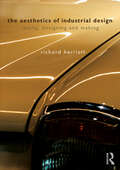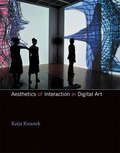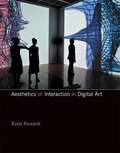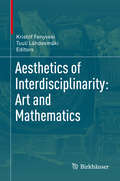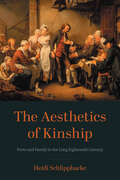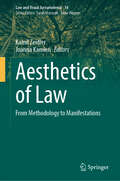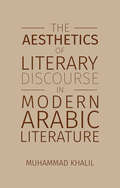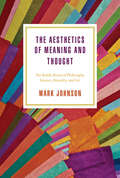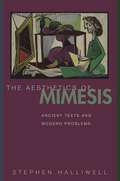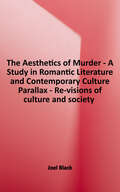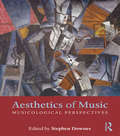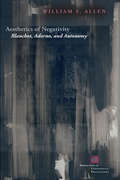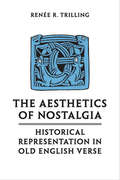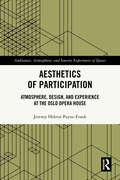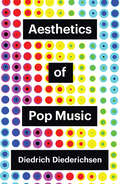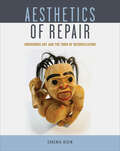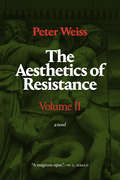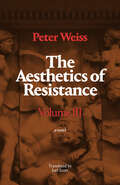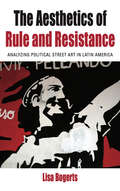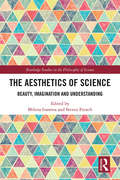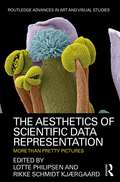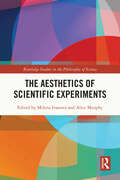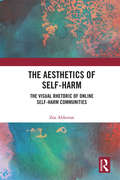- Table View
- List View
The Aesthetics of Industrial Design: Seeing, Designing and Making
by Richard HerriottThis textbook introduces design students to key principles of three-dimensional form, bridging aesthetics and practical design objectives. It explores how we see and what it is that characterises visually appealing and satisfactory design. Written by an experienced designer, educator and researcher, The Aesthetics of Industrial Design equips students with the knowledge and understanding of how aesthetically superior design is distinct from lesser work. It explains the key principles and concepts they can incorporate into their own designs, encourages readers to investigate and experiment with real design problems and enables them to verbally communicate their design intentions. The book prompts readers to critically reflect on their work and surroundings. Through numerous clear examples and illustrated case studies, which are guided by cognitive science and the application of aesthetic theory, the book brings together the basic aspects of design as form-giving. It explores the balance of function, material and appearance in detail and explains the reasons for common aesthetic faults and how to avoid them. Aimed at undergraduate- and postgraduate-level students within the design fields, this book reveals the secrets to aesthetically successful products that readers can take from education into future practice.
Aesthetics of Interaction in Digital Art (The\mit Press Ser.)
by Katja KwastekAn art-historical perspective on interactive media art that provides theoretical and methodological tools for understanding and analyzing digital art.Since the 1960s, artworks that involve the participation of the spectator have received extensive scholarly attention. Yet interactive artworks using digital media still present a challenge for academic art history. In this book, Katja Kwastek argues that the particular aesthetic experience enabled by these new media works can open up new perspectives for our understanding of art and media alike. Kwastek, herself an art historian, offers a set of theoretical and methodological tools that are suitable for understanding and analyzing not only new media art but also other contemporary art forms. Addressing both the theoretician and the practitioner, Kwastek provides an introduction to the history and the terminology of interactive art, a theory of the aesthetics of interaction, and exemplary case studies of interactive media art.Kwastek lays the historical and theoretical groundwork and then develops an aesthetics of interaction, discussing such aspects as real space and data space, temporal structures, instrumental and phenomenal perspectives, and the relationship between materiality and interpretability. Finally, she applies her theory to specific works of interactive media art, including narratives in virtual and real space, interactive installations, and performance—with case studies of works by Olia Lialina, Susanne Berkenheger, Stefan Schemat, Teri Rueb, Lynn Hershman, Agnes Hegedüs, Tmema, David Rokeby, Sonia Cillari, and Blast Theory.
Aesthetics of Interaction in Digital Art
by Katja Kwastek Niamh WardeSince the 1960s, artworks that involve the participation of the spectator have received extensive scholarly attention. Yet interactive artworks using digital media still present a challenge for academic art history. In this book, Katja Kwastek argues that the particular aesthetic experience enabled by these new media works can open up new perspectives for our understanding of art and media alike. Kwastek, herself an art historian, offers a set of theoretical and methodological tools that are suitable for understanding and analyzing not only new media art but also other contemporary art forms. Addressing both the theoretician and the practitioner, Kwastek provides an introduction to the history and the terminology of interactive art, a theory of the aesthetics of interaction, and exemplary case studies of interactive media art. Kwastek lays the historical and theoretical groundwork with discussions of processual strategies of twentieth-century art and theories of aesthetic experience, process aesthetics, play, and performance. She then develops an aesthetics of interaction, discussing such aspects as real space and data space, temporal structures, instrumental and phenomenal perspectives, and the relationship between materiality and interpretability. Finally, she applies her theory to specific works of interactive media art, including narratives in virtual and real space, interactive installations, and performance -- with case studies of works by Olia Lialina, Susanne Berkenheger, Stefan Schemat, Teri Rueb, Lynn Hershman, Agnes Heged's, Tmema, David Rokeby, Sonia Cillari, and Blast Theory.
Aesthetics of Interdisciplinarity: Art and Mathematics
by Kristóf Fenyvesi Tuuli LähdesmäkiThis anthology fosters an interdisciplinary dialogue between the mathematical and artistic approaches in the field where mathematical and artistic thinking and practice merge. The articles included highlight the most significant current ideas and phenomena, providing a multifaceted and extensive snapshot of the field and indicating how interdisciplinary approaches are applied in the research of various cultural and artistic phenomena. The discussions are related, for example, to the fields of aesthetics, anthropology, art history, art theory, artistic practice, cultural studies, ethno-mathematics, geometry, mathematics, new physics, philosophy, physics, study of visual illusions, and symmetry studies. Further, the book introduces a new concept: the interdisciplinary aesthetics of mathematical art, which the editors use to explain the manifold nature of the aesthetic principles intertwined in these discussions.
The Aesthetics of Kinship: Form and Family in the Long Eighteenth Century (New Studies in the Age of Goethe)
by Heidi SchlipphackeThe Aesthetics of Kinship intervenes critically into rigidified discourses about the emergence of the nuclear family and the corresponding interior subject in the eighteenth century. By focusing on kinship constellations instead of “family plots” in seminal literary works of the period, this book presents an alternative view of the eighteenth-century literary social world and its concomitant ideologies. Whereas Enlightenment and post-Enlightenment philosophy and political theory posit the nuclear family as a microcosm for the ideal modern nation-state, literature of the period offers a far more heterogeneous image of kinship structures, one that includes members of various classes and is not defined by blood. Through a radical re-reading of the multifarious kinship structures represented in literature of the long eighteenth century, The Aesthetics of Kinship questions the inevitability of the dialectic of the Enlightenment and invokes alternative futures for conceptions of social and political life.
Aesthetics of Law: From Methodology to Manifestations (Law and Visual Jurisprudence #14)
by Kamil Zeidler Joanna KamieńThe aesthetics of law deals with the relationship between law and beauty by searching for aesthetic values in the law itself (an internal perspective), by finding material related to law in art and culture (an external perspective), and, lastly, by demonstrating the impact of legal norms on what can be broadly understood as beauty (law as a tool of aestheticization). Regarding all these phenomena, the aesthetics of law ultimately allows us to see the law more clearly and more profoundly. What is more, the law does not function, nor has it ever functioned, separately from its means of expression, which are incontrovertibly subject to aesthetic interpretation. If we think about law in this way, perceiving not only the message, but also the manner in which it is conveyed, the whole set of means and tools used, the perfection and beauty of the form, then we will see art in it. After all, the widely known and still applicable ancient maxim ius est ars boni et aequi equates law and art. This alone should be an argument for aesthetic reflection on the law, a field of endeavour that should never have been abandoned. The book’s twenty-three chapters, written by scholars from various countries and three continents, are thematically diverse. In them we present the manifestations of the aesthetics of law from an external perspective. If we accept a definition of the concept of law that is as broad as possible, not only as a synonym of a certain formalized normative system, but also including the process of its creation (legislation), its application and interpretation (jurisprudence), and even teaching on and research into it (doctrine), we can identify a wealth of aesthetic references in the law. A broadly understood aesthetics of law, approached solely from an external perspective, covers such disciplines as law and literature, the aesthetics of legal rhetoric, the trial as performance, the aesthetics ofcourthouse architecture, law in the fine arts, law in film, law and music, pictorial law, symbols of the law and legal symbols, symbols of the state and power, legal archaeology etc. The field of research is, therefore, wide. In addition to topics traditionally and obviously associated with the aesthetics of law, such as law and literature, law in the fine arts, and court rhetoric, there are chapters on e.g. legal ethics and trademarks. All authors share the belief that beauty in law is important, even when it is hidden in a caricature. Further, they argue for restoring the aesthetics of law to its proper place in philosophical and legal discourse, as doing so would yield a host of benefits for the addressees of law.
The Aesthetics of Literary Discourse in Modern Arabic Literature
by Muhammad KhalilTHE AESTHETICS OF NARRATION AND RECEPTION IN LITERARY DISCOURSE STUDIES IN ARABIC LITERATURE The book presents the aesthetic of narrative employed by literary discourse through the literary works of some Arab writers renowned in the Arab World and at international levels, as well as some Palestinian writers in Israel, through literary models dealing with reality in the areas of: poetry, short story, and novel, and through a critical view trying to elucidate the intellectual and literary value of those literary models. The book also examines the various aesthetic values that have been employed and integrated into the literary text, comprising vocabulary, definition, artistic image, and intertextuality, etc. In the field of Palestinian poetry inside Israel, we mention, for example: Fahed Abu Khadra, Rushdie Almadi, Farouk Mawasi, Mofleh Tabo'ni, Muneer Tuma, Suad Qaraman, Wafa Ayashi, Ettaf Sougayar, and others. In the field of short story and novel, we mention from the Arab world: Najib Mahfouz, Youssef Idris, and Tayeb Salih. From the Palestinian writers inside Israel, we mention: Muhammad Nafaa', Muhammad Ali Taha, Zaki Darwish, Naji Dahir, Nabil Audi, and others. Needless to emphasize that our choice of those writers was not based arbitrarily on the fact that some of them had benefited from the opportunity of critical writing and publishing, particularly the Egyptian writers Najib Mahfouz, winner of the Nobel Prize for literature in 1988, and Youssef Idris. On the contrary, most of the Palestinian writers inside Israel did not get the attention and care they deserved from the critics and publishers. Also, we hope that the book will fill an existing vacuum in Arab literary studies, especially in English. The significance of this study is that it provides the opportunity, perhaps for the first time, to expose to the reader and learner, as well as to everyone interested in Arabic literature--Arabs as well as foreigners--the essence of the Palestinian literary movement, specifically inside Israel, through special models of the product of some of these creators which were produced under the shadow of social, cultural, and political conditions of the most difficult kind. Also, the study presents critical models that can constitute a qualitative addition to the Palestinian literary works inside Israel, as well as to the literary works in the Arab world. It was necessary to monitor those literary activities, not only in the Arabic language, but also in a universal foreign language. This may require opening windows towards others in order to achieve the greatest possible acculturation and the dialogue of civilizations in all fields of life and knowledge. This can give the Palestinian literary movement inside Israel a golden opportunity to advance and spread on a larger scale--and therein we will find the meaning of human happiness.
The Aesthetics of Meaning and Thought: The Bodily Roots of Philosophy, Science, Morality, and Art
by Mark JohnsonAll too often, we think of our minds and bodies separately. The reality couldn’t be more different: the fundamental fact about our mind is that it is embodied. We have a deep visceral, emotional, and qualitative relationship to the world—and any scientifically and philosophically satisfactory view of the mind must take into account the ways that cognition, meaning, language, action, and values are grounded in and shaped by that embodiment. This book gathers the best of philosopher Mark Johnson’s essays addressing questions of our embodiment as they deal with aesthetics—which, he argues, we need to rethink so that it takes into account the central role of body-based meaning. Viewed that way, the arts can give us profound insights into the processes of meaning making that underlie our conceptual systems and cultural practices. Johnson shows how our embodiment shapes our philosophy, science, morality, and art; what emerges is a view of humans as aesthetic, meaning-making creatures who draw on their deepest physical processes to make sense of the world around them.
The Aesthetics of Mimesis: Ancient Texts and Modern Problems
by Stephen HalliwellMimesis is one of the oldest, most fundamental concepts in Western aesthetics. This book offers a new, searching treatment of its long history at the center of theories of representational art: above all, in the highly influential writings of Plato and Aristotle, but also in later Greco-Roman philosophy and criticism, and subsequently in many areas of aesthetic controversy from the Renaissance to the twentieth century. Combining classical scholarship, philosophical analysis, and the history of ideas--and ranging across discussion of poetry, painting, and music--Stephen Halliwell shows with a wealth of detail how mimesis, at all stages of its evolution, has been a more complex, variable concept than its conventional translation of "imitation" can now convey. Far from providing a static model of artistic representation, mimesis has generated many different models of art, encompassing a spectrum of positions from realism to idealism. Under the influence of Platonist and Aristotelian paradigms, mimesis has been a crux of debate between proponents of what Halliwell calls "world-reflecting" and "world-simulating" theories of representation in both the visual and musico-poetic arts. This debate is about not only the fraught relationship between art and reality but also the psychology and ethics of how we experience and are affected by mimetic art. Moving expertly between ancient and modern traditions, Halliwell contends that the history of mimesis hinges on problems that continue to be of urgent concern for contemporary aesthetics.
The Aesthetics of Murder: A Study in Romantic Literature and Contemporary Culture
by Joel BlackWhat connects the Romantic essays of Thomas De Quincey and the violent cinema of Brian De Palma? Or the "beautiful" suicides of Hedda Gabler and Yukio Mishima? Or the shootings of John Lennon and Ronald Reagan? In The Aesthetics of Murder, Joel Black explores the sometimes gruesome interplay between life and art, between actual violence and images of violence in a variety of literary texts, paintings, and films. Rather than exclude murder from critical consideration by dismissing it as a crime, Black urges us to ponder the killer's artistic role—and our own experience as audience, witness, or voyeur. Black examines murder as a recurring, obsessive theme in the Romantic tradition, approaching the subject from an aesthetic rather than a moral, psychological, or philosophical perspective. And he brings into his discussion contemporary instances of sensational murders and assassinations, treating these as mimetic or cathartic activities in their own right. Combining historical documentation with theoretical insights, Black shows that the possibilities of representing violence—and of experiencing it—as art were recognized early in the nineteenth century as logical extensions of Romantic theories of the sublime. Since then, both traditional art forms and the modern mass media have contributed to the growing aestheticization of violence.
Aesthetics of Music: Musicological Perspectives
by Stephen DownesAesthetics of Music: Musicological Approaches is an anthology of fourteen essays, each addressing a single key concept or pair of terms in the aesthetics of music, collectively serving as an authoritative work on musical aesthetics that remains as close to 'the music' as possible. Each essay includes musical examples from works in the 18th, 19th, and into the 20th century. Topics have been selected from amongst widely recognised central issues in musical aesthetics, as well as those that have been somewhat neglected, to create a collection that covers a distinctive range of ideas. All essays cover historical origins, sources, and developments of the chosen idea, survey important musicological approaches, and offer new critical angles or musical case studies in interpretation.
Aesthetics of Negativity: Blanchot, Adorno, and Autonomy (Perspectives in Continental Philosophy)
by William S. AllenMaurice Blanchot and Theodor W. Adorno are among the most difficult but also the most profound thinkers in twentieth-century aesthetics. While their methods and perspectives differ widely, they share a concern with the negativity of the artwork conceived in terms of either its experience and possibility or its critical expression. Such negativity is neither nihilistic nor pessimistic but concerns the status of the artwork and its autonomy in relation to its context or its experience. For both Blanchot and Adorno negativity is the key to understanding the status of the artwork in post-Kantian aesthetics and, although it indicates how art expresses critical possibilities, albeit negatively, it also shows that art bears an irreducible ambiguity such that its meaning can always negate itself. This ambiguity takes on an added material significance when considered in relation to language as the negativity of the work becomes aesthetic in the further sense of being both sensible and experimental, and in doing so the language of the literary work becomes a form of thinking that enables materiality to be thought in its ambiguity.In a series of rich and compelling readings, William S. Allen shows how an original and rigorous mode of thinking arises within Blanchot’s early writings and how Adorno’s aesthetics depends on a relation between language and materiality that has been widely overlooked. Furthermore, by reconsidering the problem of the autonomous work of art in terms of literature, a central issue in modernist aesthetics is given a greater critical and material relevance as a mode of thinking that is abstract and concrete, rigorous and ambiguous. While examples of this kind of writing can be found in the works of Blanchot and Beckett, the demands that such texts place on readers only confirm the challenges and the possibilities that literary autonomy poses to thought.
The Aesthetics of Nostalgia: Historical Representation in Old English Verse
by Renee R. TrillingHeroic poetry was central to the construction of Anglo-Saxon values, beliefs, and community identity and its subject matter is often analyzed as a window into Anglo-Saxon life. However, these poems are works of art as well as vehicles for ideology. Aesthetics of Nostalgia reads Anglo-Saxon historical verse in terms of how its aesthetic form interacted with the culture and politics of the period. Examining the distinctive poetic techniques found in vernacular historic poetry, Renée R. Trilling argues that the literary construction of heroic poetry promoted specific kinds of historical understanding in early medieval England, distinct from linear and teleological perceptions of the past. The Aesthetics of Nostalgia surveys Anglo-Saxon literary culture from the age of Bede to the decades following the Norman Conquest in order to explore its cultural impact through both its content and its form.
Aesthetics of Participation: Atmosphere, Design, and Experience at the Oslo Opera House (Ambiances, Atmospheres and Sensory Experiences of Spaces)
by Jeremy Hektor Payne-FrankThis book explores the way people participate with the Oslo Opera House, Norway. As an iconic and culture-led building, these different modes of participation reveal the tensions between staged space and individual experience.Movement, materiality, light, and art are viewed through an atmospheric lens to demonstrate how architecture can shape people’s engagement with, and understanding of, urban space. This book contributes to a growing literatureon atmosphere in relation to our experience of the built environment. In adopting this atmospheric perspective, the book speaks to the concerns of designers, users, and researchers interested in the way contemporary development infuses our cities with the experiential, as a means of developing access, participation, and democracy. It explores the ways in which people experience a building, held up against the claims, intentions, and assumptions that surround it. The book’s focus on design, participation, and experience, in relation to political ideals, will appeal to architects, planners, and academics concerned with the production of space. Equally, its underlying atmospheric contribution and methodological approach will be of interest to designers, scholars, professionals, and students of ambiance, affect and atmosphere, architecture, city planners and urban developers, human geographies, anthropology, and urban studies.
Aesthetics of Pop Music (Theory Redux)
by Diedrich DiederichsenIn this short book, the leading German cultural critic Diedrich Diederichsen puts forward a fresh and original account of pop music. He argues that pop music is not so much a form of music as a constellation of different media channels, social spaces and behavioural systems, of which music is only a part. Its own logic of attraction is based less on compositions and the expression of subjectivity and more on indexicality, real or pseudo-involuntary effects as recorded by sound technologies, and on studio discipline and staging, and hence on performance. By elaborating his innovative account of pop music as a constellation, Diederichsen develops a theory that distinguishes itself from sociology, cultural studies, media studies and ethnography, while at the same time drawing on and encompassing them all.
Aesthetics of Repair: Indigenous Art and the Form of Reconciliation
by Eugenia KisinAesthetics of Repair analyses how the belongings called “art” are mobilized by Indigenous artists and cultural activists in British Columbia, Canada. Drawing on contemporary imaginaries of repair, the book asks how diverse forms of collective reckoning with settler-colonial harm resonate with urgent conversations about aesthetics of care in art. The discussion moves across urban and remote spaces of display for Northwest Coast–style Indigenous art, including galleries and museums, pipeline protests, digital exhibitions, an Indigenous-run art school, and a totem pole repatriation site. The book focuses on the practices around art and artworks as forms of critical Indigenous philosophy, arguing that art’s efficacies in this moment draw on Indigenous protocols for enacting justice between persons, things, and territories. Featuring examples of belongings that embody these social relations – a bentwood box made to house material memories, a totem pole whose return replenishes fish stocks, and a copper broken on the steps of the federal capital – each chapter shows how art is made to matter. Ultimately, Aesthetics of Repair illuminates the collision of contemporary art with extractive economies and contested practices of “resetting” settler-Indigenous relations.
The Aesthetics of Resistance, Volume II: Volume 2
by Peter WeissA major literary event, the publication of the second volume of Peter Weiss's three-volume novel The Aesthetics of Resistance makes one of the towering works of twentieth-century German literature available to English-speaking readers for the first time. The crowning achievement of Peter Weiss, the internationally renowned writer best known for his play Marat/Sade, The Aesthetics of Resistance spans the period from the late 1930s to World War II, dramatizing antifascist resistance and the rise and fall of proletarian political parties in Europe.<P><P>Volume II, initially published in 1978, opens with the unnamed narrator in Paris after having retreated from the front lines of the Spanish Civil War. From there, he moves on to Stockholm, where he works in a factory, becomes involved with the Communist Party, and meets Bertolt Brecht. Featuring the narrator's extended meditations on paintings, sculpture, and literature, the novel teems with characters, almost all of whom are based on historical figures. Throughout, the narrator explores the affinity between political resistance and art—the connection at the heart of Weiss's novel. Weiss suggests that meaning lies in embracing resistance, no matter how intense the oppression, and that we must look to art for new models of political action and social understanding. The Aesthetics of Resistance is one of the truly great works of postwar German literature and an essential resource for understanding twentieth-century German history.
The Aesthetics of Resistance, Volume III: A Novel, Volume 3
by Peter WeissA major literary event, the publication of the final volume of Peter Weiss’s three-volume novel The Aesthetics of Resistance makes one of the towering works of twentieth-century German literature available to English-speaking readers for the first time. Weiss’s crowning achievement, The Aesthetics of Resistance spans the period from the late 1930s to the end of World War II, dramatizing antifascist resistance and the rise and fall of proletarian political parties in Europe.Volume III, initially published in 1981, teems with characters, many of whom are based on historical figures. It commences in May of 1940, as the narrator’s parents flee Nazi forces in Eastern Europe and reunite with their son in Sweden. While in Stockholm, the narrator and other Communist activists living in exile struggle to build structures in the German underground. The story then follows Communist resistance fighter Charlotte Bischoff as she is smuggled to Bremen on a freighter. In Berlin, she contacts the narrator’s friends and joins the Red Orchestra resistance group. Soon, the Gestapo cracks the underground group’s code, arrests a number of its members, and takes them to Plötzensee Prison, where most of them are executed. Featuring the narrator’s meditations on paintings, sculpture, and literature throughout, The Aesthetics of Resistance demonstrates the affinity between political resistance and art. Ultimately, Weiss argues that we must look to art for new models of political action and social understanding.
The Aesthetics of Rule and Resistance: Analyzing Political Street Art in Latin America (Protest, Culture & Society #29)
by Lisa BogertsEffective visual communication has become an essential strategy for grassroots political activists, who use images to publicly express resistance and make their claims visible in the struggle for political power. However, this “aesthetics of resistance” is also employed by political and economic elites for their own purposes, making it increasingly difficult to distinguish from the “aesthetics of rule.” Through illuminating case studies of street art in Buenos Aires, Bogotá, Caracas, and Mexico City, The Aesthetics of Rule and Resistance explores the visual strategies of persuasion and meaning-making employed by both rulers and resisters to foster self-legitimization, identification, and mobilization.
The Aesthetics of Rule and Resistance: Analyzing Political Street Art in Latin America (Protest, Culture & Society #29)
by Lisa BogertsEffective visual communication has become an essential strategy for grassroots political activists, who use images to publicly express resistance and make their claims visible in the struggle for political power. However, this “aesthetics of resistance” is also employed by political and economic elites for their own purposes, making it increasingly difficult to distinguish from the “aesthetics of rule.” Through illuminating case studies of street art in Buenos Aires, Bogotá, Caracas, and Mexico City, The Aesthetics of Rule and Resistance explores the visual strategies of persuasion and meaning-making employed by both rulers and resisters to foster self-legitimization, identification, and mobilization.
The Aesthetics of Science: Beauty, Imagination and Understanding (Routledge Studies in the Philosophy of Science)
by Milena Ivanova Steven FrenchThis volume builds on two recent developments in philosophy on the relationship between art and science: the notion of representation and the role of values in theory choice and the development of scientific theories. Its aim is to address questions regarding scientific creativity and imagination, the status of scientific performances—such as thought experiments and visual aids—and the role of aesthetic considerations in the context of discovery and justification of scientific theories. Several contributions focus on the concept of beauty as employed by practising scientists, the aesthetic factors at play in science and their role in decision making. Other essays address the question of scientific creativity and how aesthetic judgment resolves the problem of theory choice by employing aesthetic criteria and incorporating insights from both objectivism and subjectivism. The volume also features original perspectives on the role of the sublime in science and sheds light on the empirical work studying the experience of the sublime in science and its relation to the experience of understanding. The Aesthetics of Science tackles these topics from a variety of novel and thought-provoking angles. It will be of interest to researchers and advanced students in philosophy of science and aesthetics, as well as other subdisciplines such as epistemology and philosophy of mathematics.
The Aesthetics of Scientific Data Representation: More than Pretty Pictures (Routledge Advances in Art and Visual Studies)
by Lotte Philipsen Rikke Schmidt KjærgaardHow can cartoon images aid in understanding bacterial biological processes? What prompts physicists to blur their images before showing them to biologists? Considering that the astronomer’s data consists solely of invisible, electric impulses, what is the difference between representing outer space as images, graphs, or sound? How does a work of contemporary art differ from a scientific image if we cannot visually distinguish between the two? How do aesthetics, art, and design influence scientific visualization and vice versa? This volume asks critically important questions about scientific data representation and provides significant insights to a field that is interdisciplinary in its very core. The authors investigate scientific data representation through the joint optics of the humanities and natural sciences. The volume particularly appeals to scholars in visual and aesthetic studies, data visualization, scientific illustration, experience culture, information design, and science communication.
The Aesthetics of Scientific Experiments (Routledge Studies in the Philosophy of Science)
by Milena Ivanova Alice MurphyThe relationship between aesthetics and science has begun to generate substantial interest. However, for the most part, the focus has been on the beauty of theories, and other aspects of scientific practice have been neglected. This book offers a novel perspective on aesthetics in experimentation via ten original essays from an interdisciplinary group comprised of philosophers, historians of science and art, and artists. The collection provides an analysis of the concept of beauty in the evaluation of experiments. What properties do practicing experimenters value? How have the aesthetic properties of scientific experiments changed over the years? Secondly, the volume looks at the role that aesthetic factors, including negative values such as ugliness, as well as experiences of the sublime and the profound, play in the construction of an experiment and its reception. Thirdly, the chapters provide in-depth historical case studies from the Royal Society, which also allows for a study of the depiction of scientific experiment in artworks, as well as contemporary examples from the LHC and cases of AI-designed experiments. Finally, it offers a exploration of the commonalities between how we learn from experiments on the one hand, and the cognitive value of artworks on the other. The Aesthetics of Scientific Experiments will be of interest to researchers and advanced students working in philosophy and history of science, and philosophy and history of art, as well as practicing scientists.
The Aesthetics of Self-Becoming: How Art Forms Empower (Routledge Research in Aesthetics)
by Paul CrowtherThis book shows that art involves an aesthetics of self-becoming, wherein we do not simply consume artistic meaning, but become empowered—by adapting ourselves to what creation in the different art forms makes possible. Paul Crowther argues that the great political task in aesthetics is no longer the creation of political art as such, but rather the winning back of art and aesthetics as central societal concerns. This involves the overcoming of neo-liberal treatments of art as mere commodity and misguided attitudes that dismiss it as the product of dead white European males. The book begins with a theory of self-consciousness which reveals the necessary role played by the aesthetic in personal identity. It then emphasises how art forms empower through processes of making and aesthetic effects that are unique to them individually. To show this, he considers the ontology of pictorial art, sculpture, installation and assemblage works, architecture, literature, cinema, and music. His arguments concerning these are supported, throughout, by in-depth discussions of specific artworks. The book’s effect, overall is to reorientate aesthetics by showing how art empowers through its revelation of new possibilities of experience. The Aesthetics of Self-Becoming will appeal to philosophers of art and aesthetics, as well as scholars in art history, literary studies, film studies, and music theory who are interested in the book’s central concerns.
The Aesthetics of Self-Harm: The Visual Rhetoric of Online Self-Harm Communities
by Zoe AldertonThe Aesthetics of Self-Harm presents a new approach to understanding parasuicidal behaviour, based upon an examination of online communities that promote performances of self-harm in the pursuit of an idealised beauty. The book considers how online communities provide a significant level of support for self-harmers and focuses on relevant case studies to establish a new model for the comprehension of the online supportive community. To do so, Alderton explores discussions of self-harm and disordered eating on social networks. She examines aesthetic trends that contextualise harmful behavior and help people to perform feelings of sadness and vulnerability online. Alderton argues that the traditional understanding of self-violence through medical discourse is important, but that it misses vital elements of human group activity and the motivating forces of visual imagery. Covering psychiatry and psychology, rhetoric and sociology, this book provides essential reading for psychologists, sociologists and anthropologists exploring group dynamics and ritual, and rhetoricians who are concerned with the communicative powers of images. It should also be of great interest to medical professionals dealing with self-harming patients.
